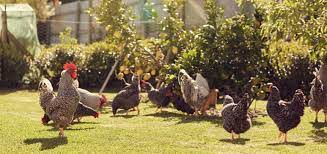
Chicken coops provide a space for your flock to live and rest without exposing them to weather elements or predators. A functional coop features windows for natural light (chickens’ egg production is regulated by sunlight) and doors for access for cleaning and collecting eggs.
Ensure your chicken coop has sufficient roosting space to accommodate the size of your flock. This reduces stress, prevents pecking order disputes and keeps poop off the ground.
Design

The materials used in coop construction can have a major impact on flock health and comfort. Traditional fixed coop designs with solid walls and a roof are durable, stable, and provide long-term shelter for chickens against extreme weather conditions.
A concrete floor is a good option for poultry coops, as it keeps the interior cool during warm months and dries quickly after rainfall or snowfall. Wooden floors, which are less expensive than concrete, can also be an effective choice for coops, but a sloping floor is recommended to allow water and manure to drain easily when cleaning the coop.

Ventilation is essential for a healthy chicken environment, preventing the build-up of ammonia and moisture that can lead to respiratory problems. A well-ventilated coop with strategically placed windows, doors, and vents balances fresh air intake with the expulsion of stale air.
The roosting bar is another important feature, as it allows chickens to perch at night, a natural behavior. Veteran chicken keeper Gail Damerow recommends placing the roost higher than the nest boxes, since it’s easier to clean this way. She also recommends installing droppings boards under roosts, which help remove the primary source of ammonia and moisture from the coop.
Materials
Ventilation is the key to a comfortable coop environment, maintaining proper temperature and humidity levels and preventing excessive ammonia buildup. Ventilation openings should be strategically placed to promote airflow without creating drafts that chill chickens.
A plywood floor sheds moisture more quickly than concrete or dirt, reducing the amount of water vapor in the coop air. Humidity is another factor to monitor, since high relative humidity contributes to respiratory problems for coop-housed birds.
The type of ventilation that is necessary for a chicken coop depends on climate and coop size, with a good rule of thumb being one window per roosting bar. In addition, the coop should have nesting boxes, which provide hens with secluded spaces in which to lay their eggs. Bedding material like straw, wood shavings or hay offers insulation, cushioning and absorbency.
To supplement natural ventilation, exhaust fans can be used, but should be placed out of reach so chickens don’t accidentally fly into them. Be sure to develop a backup ventilation plan in the event that power, fans or windows fail.
Ventilation

A well-ventilated coop is a necessity, regardless of the season. Ventilation eliminates excess moisture, minimises odours and prevents harmful ammonia buildup, all of which promote disease. Good ventilation also allows fresh air to replace stale air, which is critical for poultry health. Ventilation must be balanced with insulation to keep the coop warm during winter and cool in summer.
The coop should be equipped with functioning windows to let in natural light. Hens’ reproductive cycles are regulated by light, and if they do not get enough sunlight they will stop producing eggs.
Feeding and watering systems must be located away from roosting areas to avoid contamination. Chickens often spill feed onto the bedding, which provides sustenance for pathogens, and spilt water creates damp conditions that lead to diseases.

Consider using automatic feeders to minimise waste and provide a consistent diet. Also use open-topped water containers that can be cleaned regularly to ensure hygienic conditions and avoid rodent infestations. Nipple drinkers, which allow chickens to peck at valves to release water, are another way to minimise wastage and keep the water clean.
Feeding and Watering
A well-functioning feed and watering system is crucial for a healthy flock. Chickens need easy access to food and water that is free of contamination from poop. This means a feeder with a lid to prevent rodents and native birds from stealing food, and a waterer that is spill-proof and can be easily cleaned. The coop should be properly shaded to help keep the water cool and reduce algae growth, especially during our hot Aussie summers.
Hens also need a comfortable place to roost at night. A roosting bar or perch can be made from a piece of wood, a branch, or even a tree trunk. They should be placed at a height that allows for the natural pecking order and prevents overcrowding.
A functioning window provides natural light and circulation, helping to stimulate egg production and keep the coop clean. Windows should be secured using hardware cloth to guard against predators.
Security
Predator protection is a big part of making sure your chickens are happy and healthy. It only takes one voracious predator to wipe out a flock of chickens or chicks, so you need to take steps to protect your flock.
Start with a sturdy, secure chicken coop that is well-constructed using durable materials and a high-quality roof. The best coops are built to withstand both predators and extreme weather conditions. The door should have a lock and latch that can prevent unauthorized access by predators or people. The chicken coop should also be situated in a location that shields the flock from ground-based predators. If you want to let your flock roam free at night, make sure they’re protected by an attached run that is secured with a wire fence that can deter aerial attacks from predators such as hawks or owls.
Consider adding a roost to the chicken coop so that your flock can roost safely at night off the ground. Providing enough roost space will help keep your chickens comfortable, prevent pecking order disputes and reduce stress. Also add windows and doors to the coop that are covered with hardware cloth to discourage foxes, coyotes and other predators from entering while allowing airflow.
